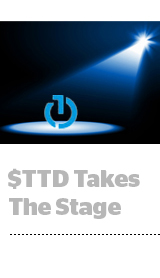 Advertisers spent $1.55 billion on The Trade Desk’s platform in 2017, helping the DSP grow its annual revenue 52% to $308 million, the company disclosed in its Q4 2017 earnings report Thursday.
Advertisers spent $1.55 billion on The Trade Desk’s platform in 2017, helping the DSP grow its annual revenue 52% to $308 million, the company disclosed in its Q4 2017 earnings report Thursday.
Shares increased more than 10% during after-hours trading.
The Trade Desk also cleared another milestone, with mobile surpassing desktop display last year for the first time, though the company doesn’t break out revenue numbers by channel.
But don’t get too hung up on the dynamics of mobile vs. display. The programmatic development behind channels like display, mobile and native is “all a dress rehearsal” for the eventual convergence of television advertising, connected TVs and digital video, said founder and CEO Jeff Green.
Connected TV revenue and inventory has been growing at exponential year-over-year rates, Green said, and 2018 is “the year it becomes material” to the company’s overall revenue picture.
In a few years programmatic television will, in turn, surpass mobile, he said.
Advertising technology players are accustomed to starting with a surfeit of supply and pounding the pavement in search of buyers.
Connected television and OTT represent “the first time in programmatic when demand has come before supply,” Green said.
Data-driven TV budgets are enticing, but still mostly hypothetical. So how does The Trade Desk juggle revenue and expenses while it waits for an industry to materialize?
Television buys come with lower profit margins than digital media. The Trade Desk’s expenses for platform operations and technology development totaled about $119 million in 2017, up from around $67 million the year before. Those trends pressure The Trade Desk’s profitability, despite strong growth.
But the company is focused on winning share of programmatic market growth, Green said, even at the expense of its operating margin and take rate, the amount it earns per dollar spent on the platform.
As long as its take rate is between 15-20%, The Trade Desk won’t allow margin compression to shake it from the larger goal of market growth.
“At times it’s been difficult for us to invest as aggressively as we’d like” due to cash and expense concerns, Green said, but it’s a mentality he’d prefer to avoid.
“Any focus on the bottom line would take away from the real opportunity, which is to grab land,” he said.
And while programmatic inches forward within linear television, current market share gains are coming primarily from less effective forms of digital advertising, he said, such as ad networks and some forms of direct buys.
This post was syndicated from Ad Exchanger.

More Stories
Ideally hires new marketing lead
The Less Obvious Scary Things About Starting an Ad Agency
Next chapter for Clemenger BBDO with new CCO